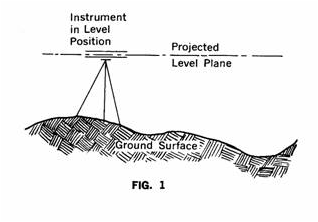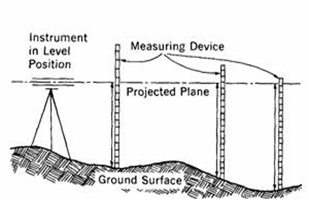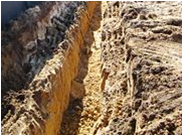Practitioner's Tool / Installation Requirements
Materials and Tools
- Builder's level or water level
- Tape measure
- Bedding material for pipeline
- Water to conduct leak test
- Shovels for excavation
Step 1. Layout. Determine the preferred route for the building sewer that will run from the building drain to the septic tank or common sewer. Measure the total length of the sewer run.
Step 2. Slope and pitch. To determine the pitch, you must know the lowest depth of the building sewer and the depth of the main sewer or entry into the septic tank. Since these two points are to be connected, you must be sure your building sewer outlet is sufficiently higher than the other to enable wastewater to drain out by gravity.
The generally accepted minimum pitch is 2 centimeters per meter. The overall pitch may be greater than this, but the best procedure is to let the building sewer have the minimum pitch from the main sewer connection to the curb, then increase the grade with 1/8-inch bends until it reaches a height sufficient to provide a 2% grade from that point to the building drain.
A 2% grade is approximately the same as a rise or fall of 2 meters in a horizontal distance of 100 meters. You can dig the trench for the sewer at this pitch according to the following instructions:
- Stretch a level line from the building at the point where the sewer will leave it to the point where the sewer will connect with the main or septic tank.
- Attach this line to a stake at both ends to hold it above ground; use a spirit level to get it horizontal.
- Lower the end of the line at the main or septic tank the necessary distance to get the proper pitch. For a horizontal run of 100 meters, lower the line 2 meters; for a run of 50 meters, lower it 1 meter; for 25 meters, lower it 0.5 meter; and so on.
- Cut a measuring stick to the length of the distance from the level line to the bottom of the drain where it leaves the building, and use this to guide the depth of the trench from the level line throughout its course.
Step 3. Excavate the trench.Be sure to over-excavate by 12 - 19 cm to allow for the bedding material.
Step 4. Place the bedding material, such as pebbles, and rake to provide an even surface at the proper pitch as described above.
Step 5. Lay out the pipe in the trench and begin attaching it starting from the building. Be sure to install the cleanouts as needed. NOTE: Take care to keep dirt and debris out of the sewer pipe.
Step 6. Make the final pipe connection.Double-check the pitch and adjust as needed by adding or removing bedding material from around the pipe. NOTE: Make sure that the pipe joints are adequately supported with bedding material. When you have the proper pitch, fill in any gaps underneath the pipe with bedding material.
Step 7. Test the pipe for leaks by installing caps on all cleanouts except the uppermost and plug the end of the sewer pipe. Fill the sewer line with water from the uppermost cleanout. Watch the water level in the cleanout pipe; if it drops more than .5 cm in one hour, repair the leaks. Since the trench has not yet been backfilled, leaks will be easy to spot.
Step 8. Backfill the trench.When satisfied that the pipe is laid at the proper pitch and is watertight, carefully fill around the pipe with remaining bedding material and cover with topsoil. Compact the soil to a slope that will allow surface water to flow (grade to drain).
Links
Visit our page on septic tanks or another septic tank page for more information.




